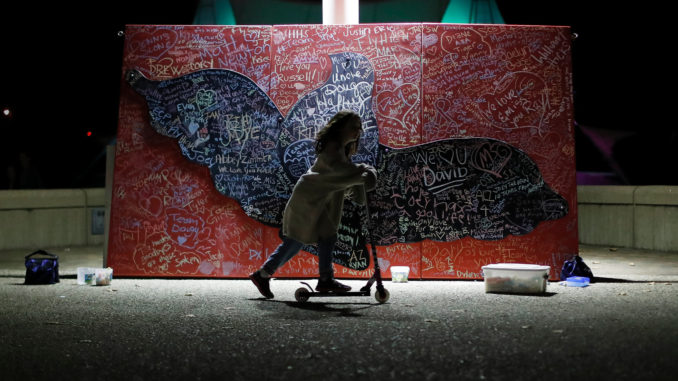
By Benedict Carey
June 7, 2018
Suicide rates rose steadily in nearly every state from 1999 to 2016, increasing 25 percent nationally, the Centers for Disease Control and Prevention reported on Thursday. In 2016, there were more than twice as many suicides as homicides.
The figures were released two days after the death of celebrity designer Kate Spade. The New York City medical examiner’s office has ruled her death a suicide.
She had struggled with depression and anxiety for years, according to a statement released by her husband, Andrew Spade. “She was actively seeking help and working closely with her doctors to treat her disease,” he wrote.
C.D.C. officials, however, said that the national increase in suicide rates cannot be linked to a particular mental health diagnosis.
The new analysis found that nearly 45,000 Americans aged 10 or older died by their own hand in 2016. The increase varied widely by state, from a low of 6 percent in Delaware to more than 57 percent in North Dakota. The rate declined in just one state, Nevada, where it has historically been higher than average.
Social isolation, lack of mental health treatment, drug and alcohol abuse and gun ownership are among the factors that contribute to suicide.
Suicide is the tenth leading cause of death in the United States, and one of three that is increasing. The other two are Alzheimer’s disease and drug overdose, in part because of the spike in opioid deaths, said Dr. Anne Schuchat, principal deputy director of the C.D.C.
Firearms were by far the leading method, accounting for about half of suicides. That number has remained steady over recent decades, she said.
Suicide rates varied from 6.9 per 100,000 residents a year in the District of Columbia to 29.2 per 100,000 in Montana.
The analysis found that slightly more than half of people who had committed suicide did not have any known mental health condition. But other problems — such as the loss of a relationship, financial setbacks, substance abuse and eviction — were common precursors, both among those who had a mental health diagnosis and those who did not.
Other studies have found much higher rates of mental health disorders among people at high risk of suicide, experts noted.
“The reason most suicide decedents don’t have a known mental disorder is that they were never diagnosed, not that they didn’t have one,” said Dr. David Brent, a professor of psychiatry at the University of Pittsburgh.
Access to guns can make it more likely that an impulsive or intoxicated person will attempt suicide even if he or she has no clear mental health problem, Dr. Brent added.
“We have worked really hard to explain to the public that suicide is not simply a matter of too much stress, but that it involves the identification and treatment of mental disorders as one important component,” he said.
In a conference call with reporters on Thursday, Dr. Schuchat and Deborah Stone, the lead author of the C.D.C. analysis, stressed that other factors were also critical to preventing suicide.
Effective strategies, she said, included teaching coping and problem-solving skills to those at risk, establishing more social “connectedness,” and safe storage of pills and guns.
The C.D.C. found that men accounted for three-quarters of all suicides, and women one-quarter. The numbers were highest among non-Hispanic whites, and among those aged 45 to 65 years old.
Previous C.D.C. reports have found rate increases of 80 percent among white, middle-aged women since 1999, and of 89 percent among Native Americans. The rates declined slightly among black men and people over age 75 during that time.
Suicide rates have waxed and waned over the country’s history and tend to reach highs in hard times. In 1932, during the Great Depression, the rate was 22 per 100,000, among the highest in modern history. The rate in the new C.D.C. data was 15.4 per 100,000.
The past three decades have presented a morbid puzzle. Rates have risen steadily in most age and ethnic groups, even as rates of psychiatric treatment and diagnosis have also greatly increased.
The reasons are many, experts sid. The biggest increases have been in states like Oklahoma, Montana and Wyoming where gun ownership, drug use and economic hardship are common. Among middle-aged people across the country, marriage rates have declined, and social isolation has increased.
Prevention has been elusive, in part because doctors have not had programs that reliably reduce suicide rates. Crisis hotlines can save lives; so can psychiatric treatment. But suicide is such an unpredictable, often impulsive act that no single intervention has proved sufficient.
“A big problem that has not yet been addressed in practice is that we continue to rely almost entirely on people themselves to proactively tell us if they are suicidal,” said Matthew Nock, a professor of psychology at Harvard University.
Yet research has shown that nearly 80 percent of people who die by suicide explicitly deny suicidal thoughts or intentions in their last communications, he added.
Researchers have only recently begun to understand the elements of suicidal thinking that actually predict an attempt.
The key risk factors include , engaging in extremely risky behavior and refusing to answer questions about suicidal thinking, or its severity, Dr. Nock said. “Using these factors, we can predict attempts with greater than 90 percent accuracy.”
Public policy changes may also help. In the past decade, a handful of states have passed legislation allowing authorities to seize firearms from people deemed mentally unstable or “dangerous.”
In a study of these laws in two states, Indiana and Connecticut, researchers at the University of Indianapolis found that the legislation led to reductions in gun-related suicides, compared to the expected numbers: they were 7.5 percent lower in Indiana in the decade following enactment, and 13.7 percent lower in Connecticut in the year since strict enforcement began.
These so-called red-flag laws “have generated interest in response to high-profile homicides, but in practice far more guns have been seized due to concerns of suicide risk,” said Aaron Kivisto, a co-author of the study with Peter Lee Phalen. “Our findings show that these laws are associated with reduced gun suicide rates.”
In 2015, most of the people who died by their own hands had alcohol or some sort drug in their blood, including tranquilizers like Valium or Xanax, and opioids.
“Our data show that suicide is more than a mental health issue,” said Dr. Schuchat. “We want improved access to care and better diagnostics, but we think that a comprehensive approach to suicide is what is needed.”
Source:https://www.nytimes.com/2018/06/07/health/suicide-rates-kate-spade.html
Visits: 74




Be the first to comment